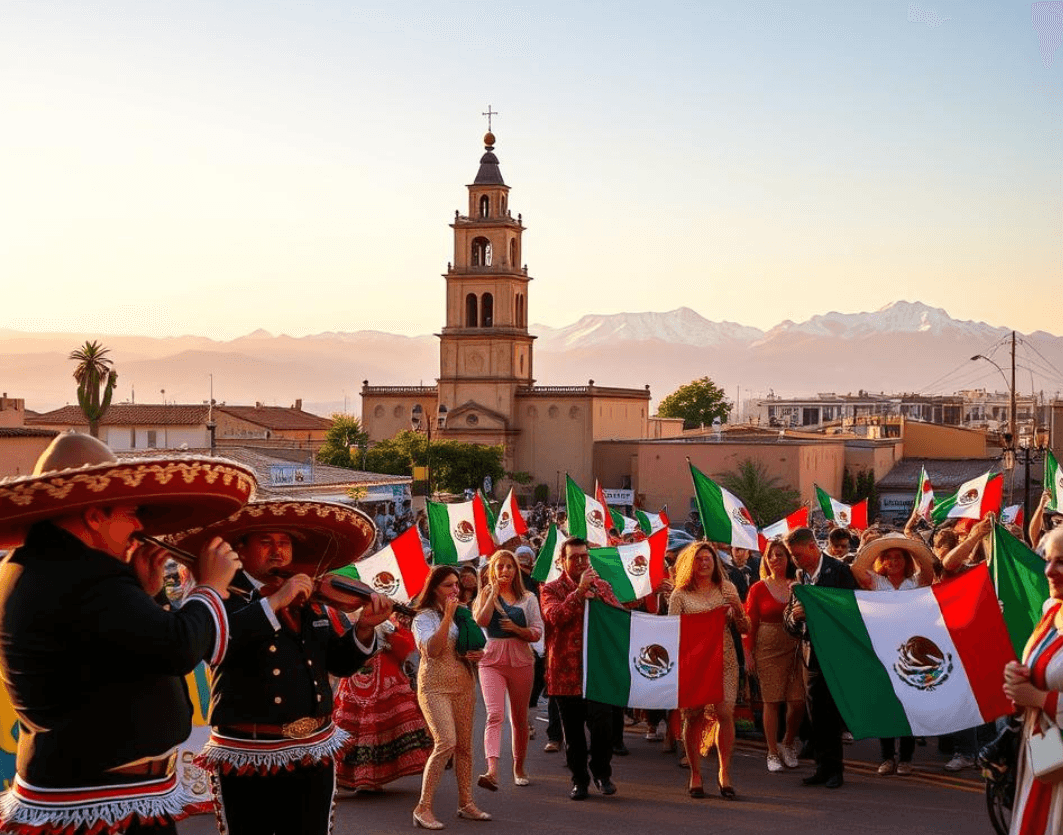Table of Contents
As we explore the rich cultural heritage of Mexico, we’re drawn to the significance of Mexican Independence Day, a pivotal moment in the country’s history.
On September 16, Mexicans commemorate the call to arms made by priest Miguel Hidalgo y Costilla in 1810, marking the beginning of the struggle for independence from Spanish colonial rule.
This celebration is not just a reflection of Mexico’s past; it’s a vibrant expression of national pride, observed with parades, festivities, and traditional food, highlighting the importance of independence in shaping the nation’s identity.
The Origins of Mexico’s Fight for Freedom
The seeds of Mexico’s independence movement were sown during the colonial period, nurtured by discontent and rebellion. The country’s fight for freedom was not a sudden occurrence but rather the culmination of centuries of social, economic, and political unrest under Spanish rule.

Life Under Spanish Colonial Rule
Life under Spanish colonial rule was characterized by strict governance and economic exploitation. The Spanish crown imposed its authority through a complex system of administration, which included the viceroyalty, audiencias, and cabildos. This system maintained control over the vast territories of New Spain, ensuring the flow of resources back to Spain. The native population and criollos (Spaniards born in the Americas) suffered under the heavy taxation and restrictive economic policies imposed by the colonial government.
The influence of the Enlightenment began to seep into the educated classes, fostering ideas of independence, liberty, and self-governance. As criollos became more educated and aware of the world beyond their colonies, they started questioning the legitimacy of Spanish rule.
Early Challenges to Spanish Authority
Prior to the full-fledged independence movement, there were several isolated challenges to Spanish authority. These included the encomenderos’ conspiracy following the New Laws of 1542, the ousting of Viceroy Gelves in 1624, Guillén Lampart’s conspiracy in 1642, and riots in Mexico City in 1692, 1785, and 1808. These events, though not directly leading to independence, indicated growing discontent among various segments of the population.
The French Revolution and the subsequent Napoleonic Wars also played a significant role in shaping political thought in New Spain. The spread of Enlightenment ideas and the success of other independence movements, such as those in the United States and Haiti, further inspired the Mexican populace. The political crisis in Spain following Napoleon’s invasion in 1808 created an opportunity for independence movements throughout Spanish America, including Mexico.
Father Miguel Hidalgo y Costilla: The Father of Mexican Independence
Miguel Hidalgo y Costilla is revered as the father of Mexican independence, a title earned through his pivotal role in the country’s fight for freedom. As a Catholic priest, Hidalgo’s influence extended beyond the spiritual realm into the social and political fabric of early 19th-century Mexico.
The Parish Priest of Dolores
Hidalgo served as the parish priest in the town of Dolores, where he became increasingly concerned about the welfare of his congregation, who were largely indigenous and mestizo. He was known for his progressive views and his commitment to social justice, which often put him at odds with the Spanish colonial authorities.

Hidalgo’s experiences in Dolores deepened his understanding of the struggles faced by the common people under Spanish rule, fueling his desire for independence.
His role as a priest gave him a unique platform to observe and address the needs of his community, from advocating for better economic opportunities to challenging the social injustices perpetuated by the colonial system.
| Aspect | Description | Impact |
|---|---|---|
| Social Justice Advocacy | Hidalgo advocated for the rights of the marginalized, including indigenous peoples and slaves. | Influenced public opinion against the colonial regime. |
| Economic Reforms | He supported land redistribution and economic opportunities for all Mexicans. | Threatened the established colonial order. |
| Vision for Independence | Hidalgo envisioned a Mexico free from Spanish rule, with equal rights for all citizens. | Inspired a nation-wide movement for mexican independence. |
His Vision for an Independent Mexico
Hidalgo’s vision for an independent Mexico was revolutionary for its time, emphasizing equality and justice for all, regardless of racial background. He was a vocal advocate for the abolition of slavery and the end of the tribute system that heavily burdened indigenous populations. His progressive agenda included significant political and economic reforms aimed at creating a more equitable society.
The concept of racial equality was particularly radical in the context of early 19th-century Mexico, where the social hierarchy was deeply entrenched. Hidalgo’s call for land redistribution and economic opportunities for all Mexicans directly challenged the status quo, making him a significant threat to the colonial authorities.
By examining Hidalgo’s vision and actions, we gain insight into the complex interplay of social, political, and economic factors that shaped Mexico’s struggle for independence under the leadership of Father Hidalgo, also known as Miguel Hidalgo.
The Grito de Dolores: The Cry That Started a Revolution
It was on September 16, 1810, that Hidalgo’s powerful oratory skills ignited the flames of revolution across Mexico. This momentous day is still celebrated today as Mexican Independence Day.

September 16, 1810: A Momentous Day
The day began like any other in the town of Dolores, but it would soon become a turning point in Mexican history. Father Miguel Hidalgo y Costilla, the parish priest, rang the church bells to gather his congregation. Instead of a routine announcement, he delivered a passionate call to arms, urging Mexicans to rise up against Spanish rule.
This event, known as the Grito de Dolores, marked the beginning of the Mexican War of Independence. The impact was immediate, with thousands rallying behind Hidalgo’s cause.
| Event | Date | Significance |
|---|---|---|
| Grito de Dolores | September 16, 1810 | Beginning of the Mexican War of Independence |
| Hidalgo’s Speech | September 16, 1810 | Call to arms against Spanish rule |
The Content and Impact of Hidalgo’s Speech
While the exact words of Hidalgo’s speech were not recorded, it is known that he called for an end to Spanish rule and for Mexicans to fight for their independence. His words inspired thousands to join his cause, beginning the long struggle for Mexican independence. The people of Mexico responded enthusiastically, and soon the movement spread beyond Dolores.
Hidalgo’s message combined religious imagery with revolutionary political ideas, resonating deeply with his audience. The immediate response to his call to arms was overwhelming, with many Mexicans eager to fight for their freedom.
The success of the Grito de Dolores can be attributed to the timing and the content of Hidalgo’s speech, which struck a chord with the people. It was a powerful call to action that galvanized a nation and paved the way for the long journey towards independence.
The Mexican War of Independence (1810-1821)
The struggle for Mexican independence was a prolonged and challenging journey that began in 1810 and concluded in 1821. This period was marked by various phases, each characterized by different leadership and strategies.

The First Phase Under Hidalgo’s Leadership
The initial phase of the Mexican War of Independence was led by Miguel Hidalgo y Costilla, a Catholic priest who issued the Grito de Dolores, a call to arms that sparked the conflict. Hidalgo’s leadership was significant, as he managed to rally a substantial following among the indigenous and mestizo populations. However, his military campaigns were ultimately unsuccessful, and he was executed in 1811.
José María Morelos and the Second Phase
Following Hidalgo’s execution, José María Morelos took up the mantle of leadership, continuing the fight for independence. Morelos was a skilled military leader who achieved several victories against the royalist forces. He also played a crucial role in convening the Congress of Anáhuac, which drafted a constitution for an independent Mexico. Despite his successes, Morelos was captured and executed in 1815, leaving the independence movement fragmented.
Vicente Guerrero and the Final Push for Freedom
The final phase of the war saw Vicente Guerrero emerge as a key leader, employing guerrilla tactics to keep the independence movement alive. The movement had reached a stalemate until 1820, when a liberal revolution in Spain prompted conservative Mexicans to switch their allegiance to the independence cause, viewing it as a means to maintain their power and stability. This unexpected turn of events ultimately led to the signing of the Treaty of Córdoba in 1821, recognizing Mexico’s independence and concluding the war.
The war independence struggle, though long and arduous, ultimately resulted in Mexico’s freedom from Spanish rule, paving the way for the country’s future development.
The Plan of Iguala and Mexico’s Final Victory
In 1821, the Plan of Iguala marked a crucial turning point in Mexico’s fight for independence. This plan, also known as the Treaty of Iguala, was a revolutionary document that laid out three guarantees for Mexico: the independence of Mexico, the establishment of Catholicism as the official religion, and social equality for all Mexicans.
Agustín de Iturbide’s Alliance with Guerrero
Agustín de Iturbide, a former royalist officer, played a pivotal role in Mexico’s final push for Mexican independence. He allied with Vicente Guerrero, a leading insurgent, to form the Army of the Three Guarantees. This alliance was crucial as it united the royalist and insurgent forces under a single banner, paving the way for a unified front against Spanish rule.
- The Army of the Three Guarantees marched towards Mexico City, symbolizing the unity and determination of the Mexican people.
- Iturbide’s strategic leadership and alliance with Guerrero were key factors in the success of the independence movement.
The Treaty of Córdoba and Spain’s Withdrawal
The final victory for Mexico came with the signing of the Treaty of Córdoba on August 24, 1821. The last Spanish viceroy, Juan O’Donojú, signed the treaty, recognizing Mexico’s independence. This was followed by the Spain’s withdrawal from Mexico as the Army of the Three Guarantees entered Mexico City triumphantly on September 27, 1821.
- The Treaty of Córdoba formalized the end of Spanish rule in Mexico, marking a significant milestone in the country’s history.
- Although Spain did not officially recognize Mexican independence until 1836, the Treaty of Córdoba was a crucial step towards international acknowledgment.
The Aftermath: Mexico’s Early Years of Independence
As Mexico gained freedom, it entered a period of significant transformation and self-definition. The struggle for independence had united the nation, but the real challenge lay in shaping the newly freed country.
The First Mexican Empire
The first attempt at self-governance was the establishment of the First Mexican Empire under Agustín de Iturbide. This short-lived empire was marked by Iturbide’s coronation as Emperor in 1822. However, his reign was met with opposition, leading to his eventual abdication in 1823. The empire’s collapse signified the end of a brief experiment in monarchical rule.
The political landscape was characterized by divisions between those who favored a centralized authority and those who advocated for greater regional autonomy.
| Key Events | Year | Impact |
|---|---|---|
| Iturbide’s Coronation | 1822 | Establishment of the First Mexican Empire |
| Iturbide’s Abdication | 1823 | End of the First Mexican Empire |
| Constitution of 1824 | 1824 | Establishment of a Federal Republic |
Transition to a Republic
Following Iturbide’s abdication, Mexico transitioned towards a federal republic. The Constitution of 1824 established Mexico as a federal republic, modeled partly after the United States. This new government structure aimed to balance power between the central authority and the states.
The early years of independence were marked by ongoing political divisions and challenges, including conflicts between centralists and federalists, economic difficulties, and foreign interventions.
Mexican Independence Day Celebrations Today
Every year, Mexicans commemorate their independence with grand celebrations that showcase their rich cultural heritage. The day is filled with a mix of official ceremonies, public festivities, and traditional practices that bring people together.
Official Ceremonies and Traditions
The official ceremonies are an integral part of Mexican Independence Day. These events are characterized by solemn rituals, patriotic speeches, and the reenactment of historical events. The colors of the Mexican flag — red, white, and green — are prominently displayed, symbolizing the nation’s unity and pride. Traditional practices, such as the Grito de Dolores, are reenacted with fervor, echoing the call for independence that sparked the revolution.
- The national flag is raised in public spaces, accompanied by the national anthem.
- Government officials and dignitaries participate in official ceremonies, paying tribute to the country’s heroes.
Public Festivities Across the Country
Beyond official ceremonies, public festivities erupt across Mexico, transforming town squares and public spaces into vibrant celebration hubs. The atmosphere is carnival-like, with music, dancing, and fireworks that light up the night sky. People from all walks of life come together, united in their national pride and cultural heritage.
The celebrations are marked by festive fireworks, fiestas, and an abundance of traditional food and music. Communities are actively involved in organizing these events, with local governments, schools, and community organizations playing a significant role. The collective joy and unity that permeate these celebrations transcend the political aspects of the holiday, making it a truly special occasion for Mexicans.
The Presidential Reenactment of the Grito
As the clock strikes midnight on September 15th, the President of Mexico rings the historic bell, echoing the call to independence made over two centuries ago. This annual ceremony is a cornerstone of Mexican Independence Day celebrations, symbolizing the nation’s ongoing commitment to its founding ideals.
The Ceremony at the National Palace
The reenactment takes place at the National Palace in Mexico City, a location steeped in history and significance. The President, surrounded by dignitaries and citizens, reenacts the Grito de Dolores, shouting the same phrases that Father Hidalgo used to rally his followers in 1810. This powerful ritual serves as a bridge between Mexico’s past and present.
The Significance of Ringing Hidalgo’s Bell
The bell that the President rings is the actual one used by Father Hidalgo, now housed at the National Palace. This act symbolically connects modern Mexico to the moment when the struggle for independence began. The emotional impact of this moment is profound, resonating with both the gathered crowds and viewers across the nation.
| Aspect | Significance |
|---|---|
| Historical Connection | The bell used is the original from 1810, creating a direct link to the past. |
| National Unity | The ceremony unites the nation, reaffirming its commitment to independence. |
| Symbolic Act | Ringing the bell symbolizes the ongoing struggle for sovereignty. |
Traditional Foods and Drinks of Mexican Independence Day
As Mexico celebrates its independence, the country’s rich culinary heritage takes center stage. The traditional foods and drinks of Mexican Independence Day are not just delicious; they are also deeply symbolic, reflecting the country’s history and cultural identity.
Chiles en Nogada: The Patriotic Dish
Chiles en Nogada is a quintessential dish for Mexican Independence Day, symbolizing the country’s struggle for independence. This dish consists of poblano peppers stuffed with a mixture of meats, fruits, and spices, topped with a creamy walnut sauce and pomegranate seeds, representing the colors of the Mexican flag: green, white, and red.
Other Festive Foods and Their Significance
Other traditional dishes include pozole, a hearty soup made with hominy and pork or chicken, and tamales, steamed corn dough filled with various meats or cheese. These dishes are significant not only for their flavor but also for the sense of community they foster during celebrations.
Traditional Beverages for the Celebration
Traditional beverages play a crucial role in the celebrations. Popular drinks include Mexican beer, sangria, tequila, and non-alcoholic options like agua fresca and Mexican ponche (fruit punch), made with fruits like oranges and guavas, and spices such as cinnamon and clove.
| Dish/Drink | Description | Significance |
|---|---|---|
| Chiles en Nogada | Poblano peppers stuffed with meats, fruits, and spices, topped with walnut sauce and pomegranate seeds. | Symbolizes Mexican flag colors and independence. |
| Pozole | Hearty soup made with hominy and pork or chicken. | Fosters community during celebrations. |
| Mexican Ponche | Fruit punch made with oranges, guavas, and spices. | Adds to the festive atmosphere. |
Music, Dance, and Cultural Expressions During the Celebration
During the festivities of Mexican Independence Day, the air is filled with the sounds of mariachi music and the vibrant colors of traditional dances. The celebration is a time when Mexico’s rich cultural heritage is showcased through various art forms, reflecting the nation’s history and regional diversity.
The Role of Mariachi Music
Mariachi music plays a significant role in the Independence Day celebrations. The lively rhythms and melodic tunes of mariachi bands add to the festive atmosphere, often accompanying traditional dances and public performances. Mariachi music is not just a form of entertainment; it’s a symbol of Mexican culture and identity. The presence of mariachi bands in town squares and public spaces during the event enhances the overall celebratory mood.
Traditional Dances and Performances
Traditional dances are an integral part of Mexican Independence Day celebrations. Various regional dances are performed in public spaces and as part of organized events, showcasing the country’s diverse cultural heritage. The Jarabe Tapatío, often considered Mexico’s national dance, is a highlight of these performances. The colorful costumes and intricate choreography make these dances visually spectacular, connecting modern Mexicans to their cultural roots and serving as expressions of national pride.
| Dance Form | Region | Description |
|---|---|---|
| Jarabe Tapatío | Jalisco | Considered Mexico’s national dance, known for its energetic and complex footwork. |
| Danra de los Viejitos | Veracruz | A dance characterized by its comedic elements and exaggerated movements. |
| Danza de los Matachines | Northern Mexico | A ritual dance with roots in indigenous and Spanish traditions. |
The diverse dance forms and cultureal expressions during Mexican Independence Day celebrations in every town highlight the nation’s rich heritage and its people’s pride in their history.
Mexican Independence Day vs. Cinco de Mayo
Mexican Independence Day and Cinco de Mayo are two distinct celebrations that have gained different levels of recognition internationally. While Mexican Independence Day commemorates the country’s struggle for independence from Spain, Cinco de Mayo has become a day to celebrate Mexican culture and heritage, particularly in the United States.
Understanding the Difference Between the Two Holidays
The primary difference between the two holidays lies in their historical significance. Mexican Independence Day, observed on September 16, marks the beginning of the Mexican War of Independence in 1810. In contrast, Cinco de Mayo, celebrated on May 5, commemorates the Mexican army’s victory over French forces at the Battle of Puebla in 1862. In Mexico, Cinco de Mayo is not as widely celebrated as Mexican Independence Day, and its significance is more regional, particularly in the state of Puebla.
Why the Confusion Exists Outside of Mexico
The confusion and differing levels of celebration between the two holidays outside of Mexico can be attributed to several factors. In the United States, Cinco de Mayo has been commercialized and promoted by food and beverage companies, turning it into a celebration of Mexican-American heritage. This commercialization has contributed to its widespread popularity. On the other hand, Mexican Independence Day remains less celebrated outside of Mexico, partly because it is not associated with the broader celebration of Mexican culture in the same way Cinco de Mayo is.
| Holiday | Date | Significance |
|---|---|---|
| Mexican Independence Day | September 16 | Commemorates the start of the Mexican War of Independence |
| Cinco de Mayo | May 5 | Celebrates the Mexican army’s victory over French forces |
The Symbolism of the Mexican Flag and National Colors
With its vibrant colors and iconic emblem, the Mexican flag represents the nation’s identity and sovereignty. The flag’s design is a reflection of Mexico’s rich history and cultural heritage.
The Meaning Behind Green, White, and Red
The Mexican flag consists of three vertical stripes: green, white, and red. Each color has a significant meaning. The green stripe symbolizes the country’s hope and independence. The white stripe represents the purity of the national ideals, while the red stripe honors the blood of the national heroes who fought for independence.
The colors together signify the nation’s struggle for sovereignty and its commitment to the principles of independence.
The Eagle, Snake, and Cactus Emblem
At the center of the white stripe is the national emblem: an eagle perched on a prickly pear cactus, devouring a snake. This image is derived from an Aztec legend about the founding of Tenochtitlan, now modern-day Mexico City. The emblem connects modern Mexico to its pre-Hispanic heritage, symbolizing the country’s rich cultural continuity.
The incorporation of this indigenous symbol into the national flag highlights the nation’s pride in its history and its connection to the pre-colonial past, serving as a powerful representation of Mexican sovereignty and culture during independence celebrations.
Conclusion: The Enduring Legacy of Mexican Independence
Mexican Independence Day is not just a celebration of the past; it’s a testament to the enduring spirit of a nation that fought for its freedom. As we reflect on the eleven-year struggle for independence, it becomes clear that this period fundamentally transformed Mexico, setting it on the path to becoming the nation it is today.
The ideals of the independence movement—liberty, equality, and sovereignty—continue to resonate in contemporary Mexican society. These principles, championed by figures like Father Miguel Hidalgo y Costilla, have become integral to Mexico’s identity and continue to inspire Mexicans both at home and abroad.
The annual celebrations of Mexican Independence Day serve as a poignant reminder of the country’s history and its journey towards self-determination. Through official ceremonies, public festivities, and traditional practices, Mexicans commemorate this pivotal moment, reaffirming their connection to their heritage and their country.
In the broader world context, Mexican Independence Day stands as a significant event, symbolizing the universal quest for freedom and self-governance. As we look back on this momentous occasion, we are reminded of the importance of understanding and appreciating the historical events that have shaped nations over time.
In conclusion, the legacy of Mexican independence continues to be felt deeply within Mexico and beyond. It is a testament to the power of the human spirit and the enduring importance of the ideals that have guided nations throughout history.
FAQ
What is the significance of Miguel Hidalgo y Costilla in Mexican history?
Miguel Hidalgo y Costilla is considered the Father of Mexican Independence because he led the initial uprising against Spanish colonial rule with his famous Grito de Dolores speech on September 16, 1810.
What is the Grito de Dolores?
The Grito de Dolores, or Cry of Dolores, was a call to arms delivered by Miguel Hidalgo y Costilla on September 16, 1810, marking the beginning of Mexico’s fight for independence from Spain.
How is Independence Day celebrated in Mexico City?
In Mexico City, the President reenacts the Grito de Dolores at the National Palace, ringing Hidalgo’s Bell, followed by festivities, fireworks, and traditional foods across the city.
What is the difference between Mexican Independence Day and Cinco de Mayo?
Mexican Independence Day on September 16 commemorates the start of the war of independence against Spain, while Cinco de Mayo on May 5 celebrates the Mexican army’s victory over French forces at the Battle of Puebla.
What are some traditional foods associated with Independence Day celebrations?
Traditional dishes include Chiles en Nogada, a patriotic dish representing the national colors, as well as other festive foods like pozole and tamales, accompanied by traditional beverages.
What is the significance of the Mexican flag and its colors?
The Mexican flag features three colors: green, white, and red, symbolizing independence, purity, and the blood of national heroes, respectively, with the eagle, snake, and cactus emblem signifying the country’s rich heritage.
How do people in Mexico celebrate their Independence Day?
People in Mexico celebrate with official ceremonies, public festivities, traditional foods, music, and dance, showcasing the nation’s cultural heritage and pride in their history.










